
Campo del Cielo refers to a group of iron meteorites and the area in Argentina where they were found. The site straddles the provinces of Chaco and Santiago del Estero, located 1,000 kilometers (620 mi) north-northwest of Buenos Aires, Argentina and approximately 500 kilometres (310 mi) southwest of Asunción, Paraguay. The crater field covers 18.5 by 3 kilometres and contains at least 26 craters, the largest being 115 by 91 metres.

An iron meteorite fell on the Sikhote-Alin Mountains, in southeastern Russia, in 1947. Large iron meteorite falls have been witnessed and fragments recovered but never before, in recorded history, a fall of this magnitude. An estimated 23 tonnes of fragments survived the fiery passage through the atmosphere and reached the Earth.

The Willamette Meteorite, officially named Willamette and originally known as Tomanowos by the Clackamas Chinook Native American tribe, is an iron-nickel meteorite found in the U.S. state of Oregon. It is the largest meteorite found in the United States and the sixth largest in the world. There was no impact crater at the discovery site; researchers believe the meteorite landed in what is now Canada or Montana, and was transported as a glacial erratic to the Willamette Valley during the Missoula Floods at the end of the last Ice Age. It has long been held sacred by indigenous peoples of the Willamette Valley, including the federally recognized Confederated Tribes of the Grand Ronde Community of Oregon (CTGRC).

The Canyon Diablo meteorite refers to the many fragments of the asteroid that created Meteor Crater, Arizona, United States. Meteorites have been found around the crater rim, and are named for nearby Canyon Diablo, which lies about three to four miles west of the crater.

The Cape York meteorite, also known as the Innaanganeq meteorite, is one of the largest known iron meteorites, classified as a medium octahedrite in chemical group IIIAB. In addition to many small fragments, at least eight large fragments with a total mass of 58 tonnes have been recovered, the largest weighing 31 tonnes. The meteorite is named after the location where the largest fragment was found: 23 miles (37 km) east of Cape York, in Savissivik, Meteorite Island, Greenland.

Meteoric iron, sometimes meteoritic iron, is a native metal and early-universe protoplanetary-disk remnant found in meteorites and made from the elements iron and nickel, mainly in the form of the mineral phases kamacite and taenite. Meteoric iron makes up the bulk of iron meteorites but is also found in other meteorites. Apart from minor amounts of telluric iron, meteoric iron is the only naturally occurring native metal of the element iron on the Earth's surface.
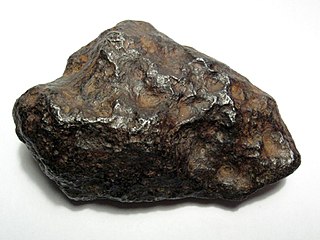
Ataxites are a structural class of iron meteorites with a high nickel content and show no Widmanstätten patterns upon etching.
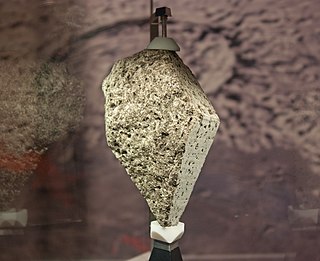
Moon rock or lunar rock is rock originating from Earth's Moon. This includes lunar material collected during the course of human exploration of the Moon, and rock that has been ejected naturally from the Moon's surface and landed on Earth as meteorites.

The pallasites are a class of stony–iron meteorite. They are relatively rare, and can be distinguished by the presence of large olivine crystal inclusions in the ferro-nickel matrix.

Iron meteorites, also called siderites or ferrous meteorites, are a type of meteorite that consist overwhelmingly of an iron–nickel alloy known as meteoric iron that usually consists of two mineral phases: kamacite and taenite. Most iron meteorites originate from cores of planetesimals, with the exception of the IIE iron meteorite group

Mesosiderites are a class of stony–iron meteorites consisting of about equal parts of metallic nickel-iron and silicate. They are breccias with an irregular texture; silicates and metal occur often in lumps or pebbles as well as in fine-grained intergrowths. The silicate part contains olivine, pyroxenes, and Ca-rich feldspar and is similar in composition to eucrites and diogenites.
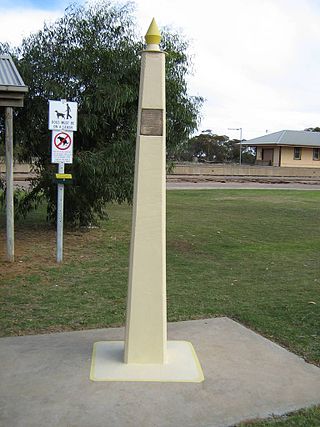
The Karoonda meteorite is a meteorite that fell to earth on 25 November 1930 at 10:53 pm near the South Australian town of Karoonda. It is of a rare composition, being carbonaceous chondrite, and is also rare in that it was found so soon after its landing. Several fragments are now held in the South Australian Museum in Adelaide.
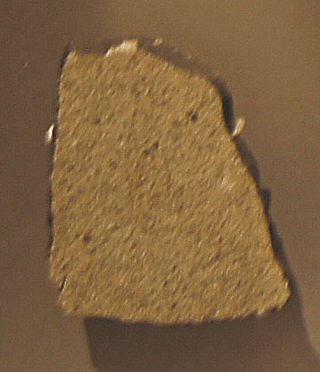
The Sylacauga meteorite fell on November 30, 1954, at 12:46 local time in Oak Grove, Alabama, near Sylacauga, in the United States. It is also commonly called the Hodges meteorite because a fragment of it struck Ann Elizabeth Fowler Hodges (1920–1972).
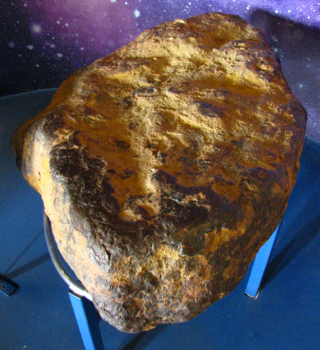
The Muonionalusta meteorite is a meteorite classified as fine octahedrite, type IVA (Of) which impacted in northern Scandinavia, west of the border between Sweden and Finland, about one million years BCE.

The Tissint meteorite is a Martian meteorite that fell in Tata Province in the Guelmim-Es Semara region of Morocco on July 18, 2011. Tissint is the fifth Martian meteorite that people have witnessed falling to Earth, and the first since 1962. Pieces of the meteorite are on display at several museums, including the Museum of Natural History of Vienna and the Natural History Museum in London.
The Iron Man statue is a 24 centimetres (9.4 in), 10 kilograms (22 lb) sculpture depicting what could be the Buddhist deity Vaiśravaṇa that may be made from a rare ataxite class nickel-rich iron meteorite. It is claimed to be Tibetan and to have been carved circa 1000 CE, from a meteorite that fell to Earth approximately 15,000 years ago, although no evidence for this claim has been provided.

The Dronino meteorite is a 40-kilogram (88 lb) iron meteorite that was found in the Ryazan Oblast of Russia in July 2000. It is classified as an ataxite.

The Nantan meteorite is an iron meteorite that belongs to the IAB group and the MG subgroup.

The Zakłodzie meteorite is a stony-iron meteorite found in Poland in 1998. Its mass is 8.68 kilograms (19.1 lb). It is composed predominantly from enstatite and meteoric iron. Currently classified as an ungrouped enstatite achondrite its classification is still an ongoing scientific debate.
The Twannberg meteorite is a hexahedrite iron meteorite. It is the only meteorite of the IIG group found in Europe and the largest meteorite ever found in Switzerland.



















